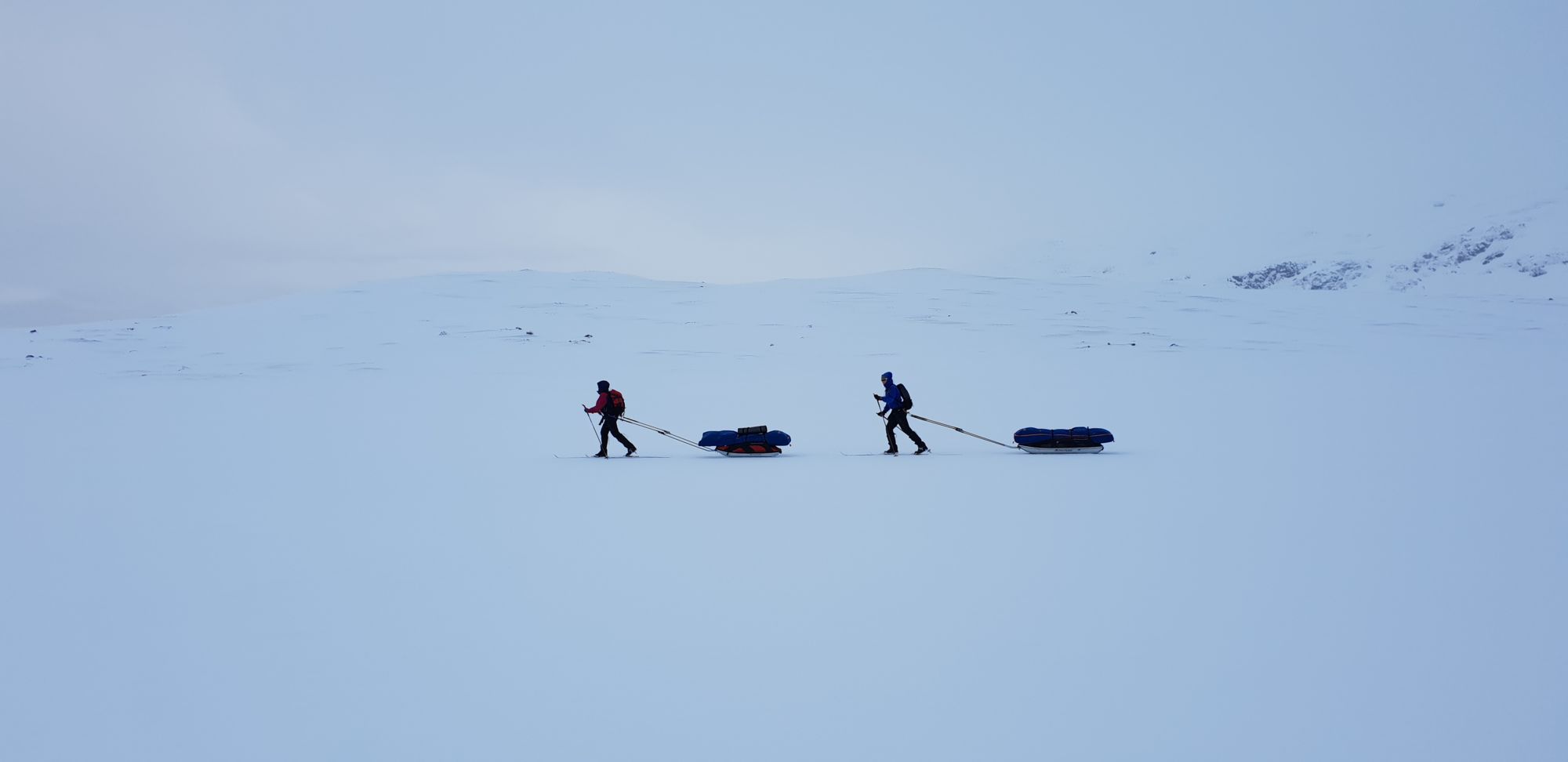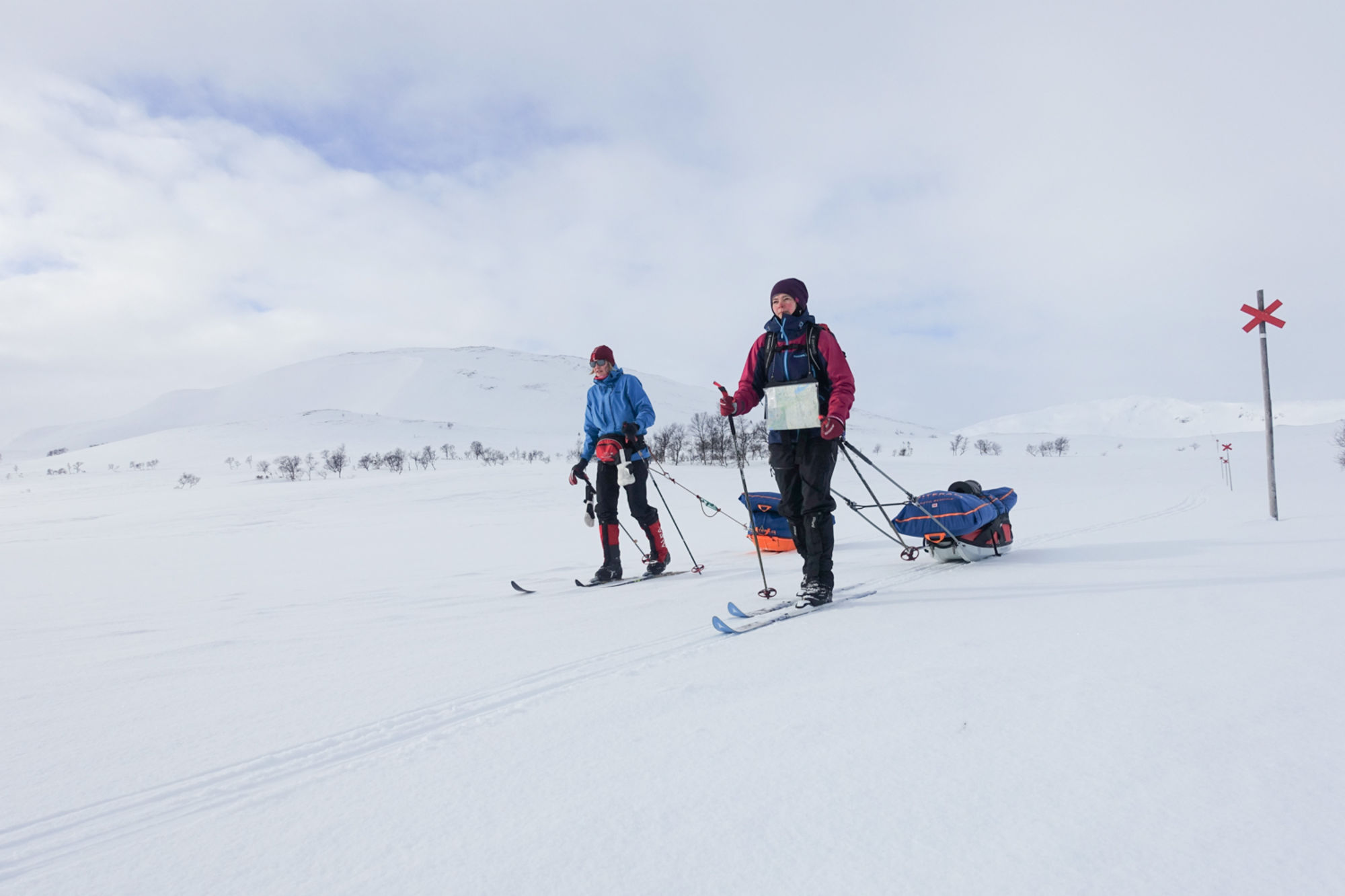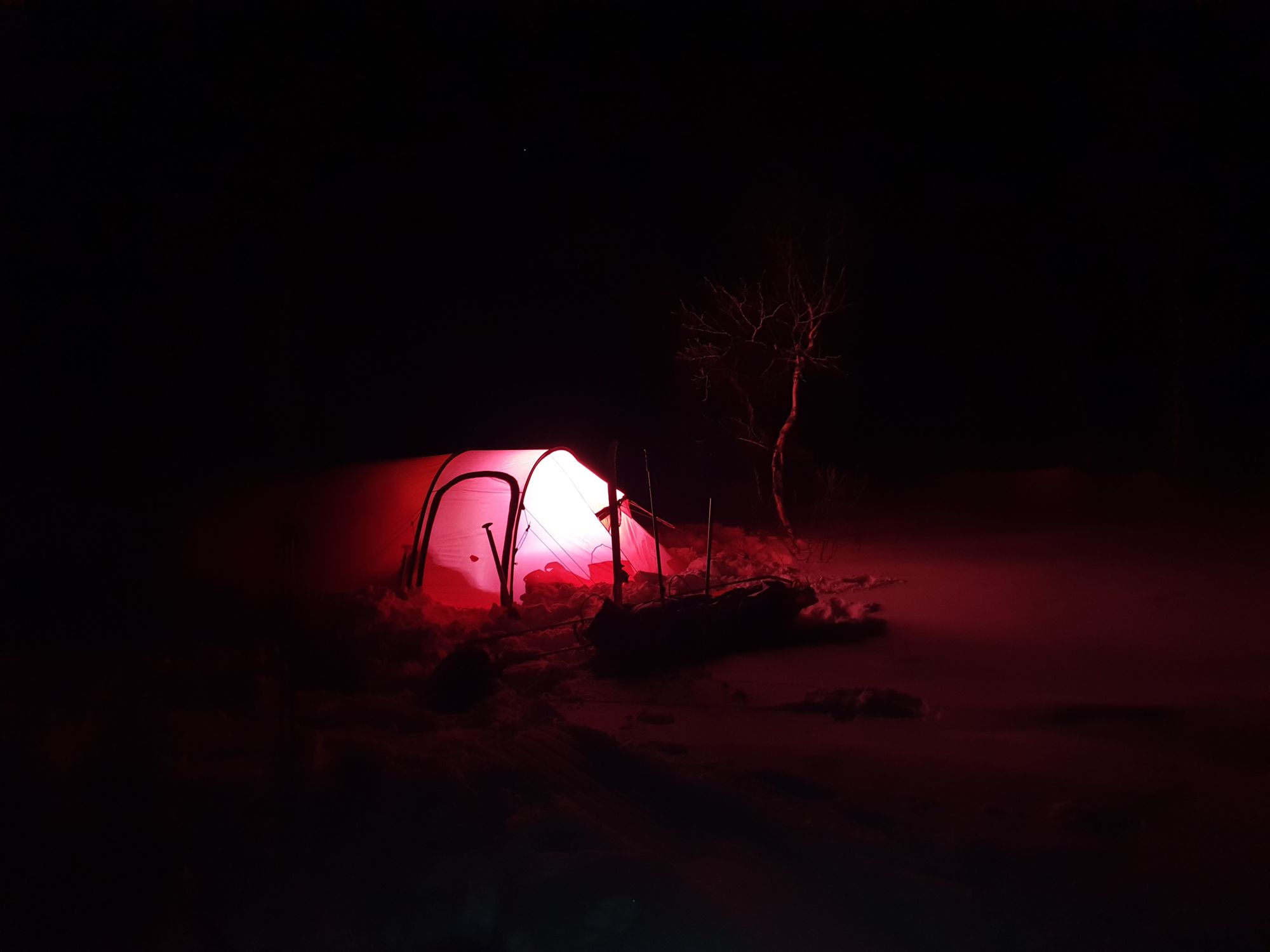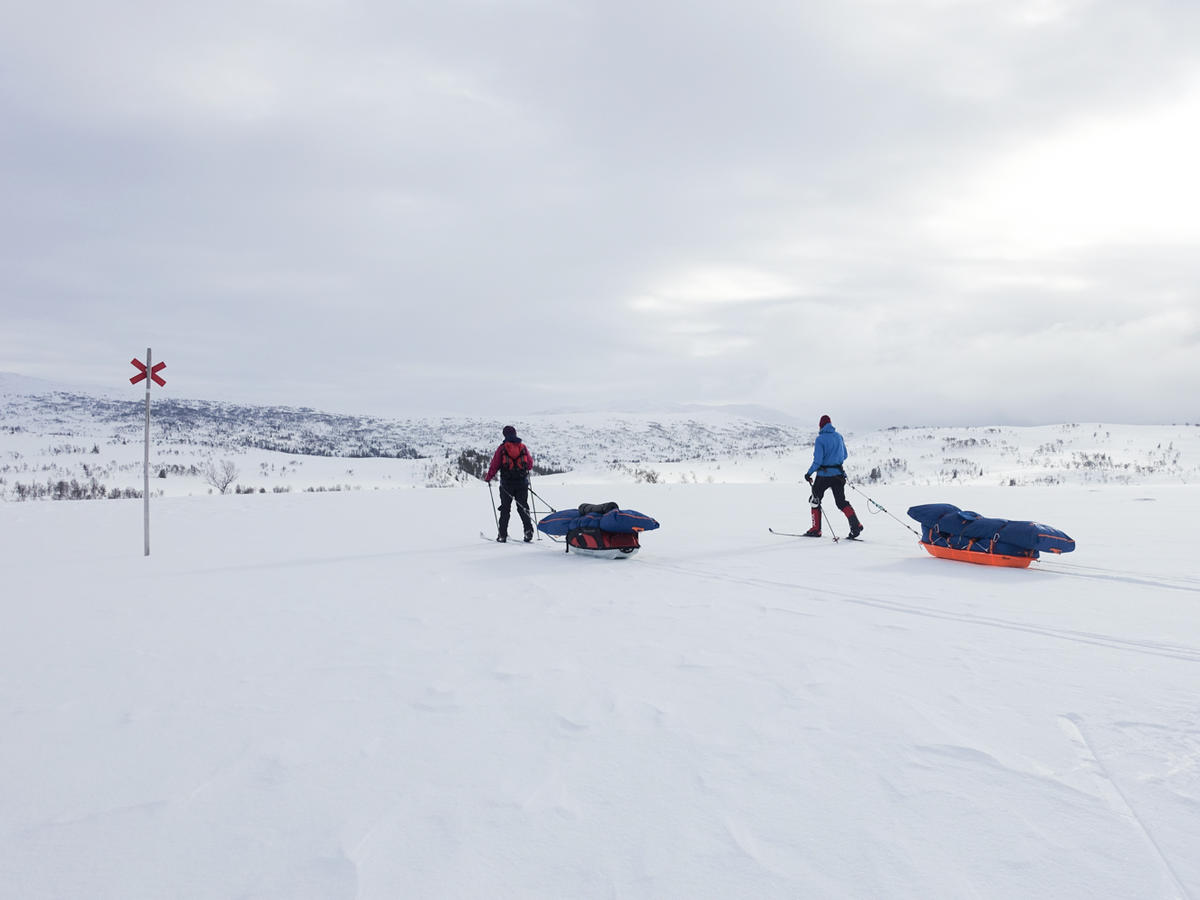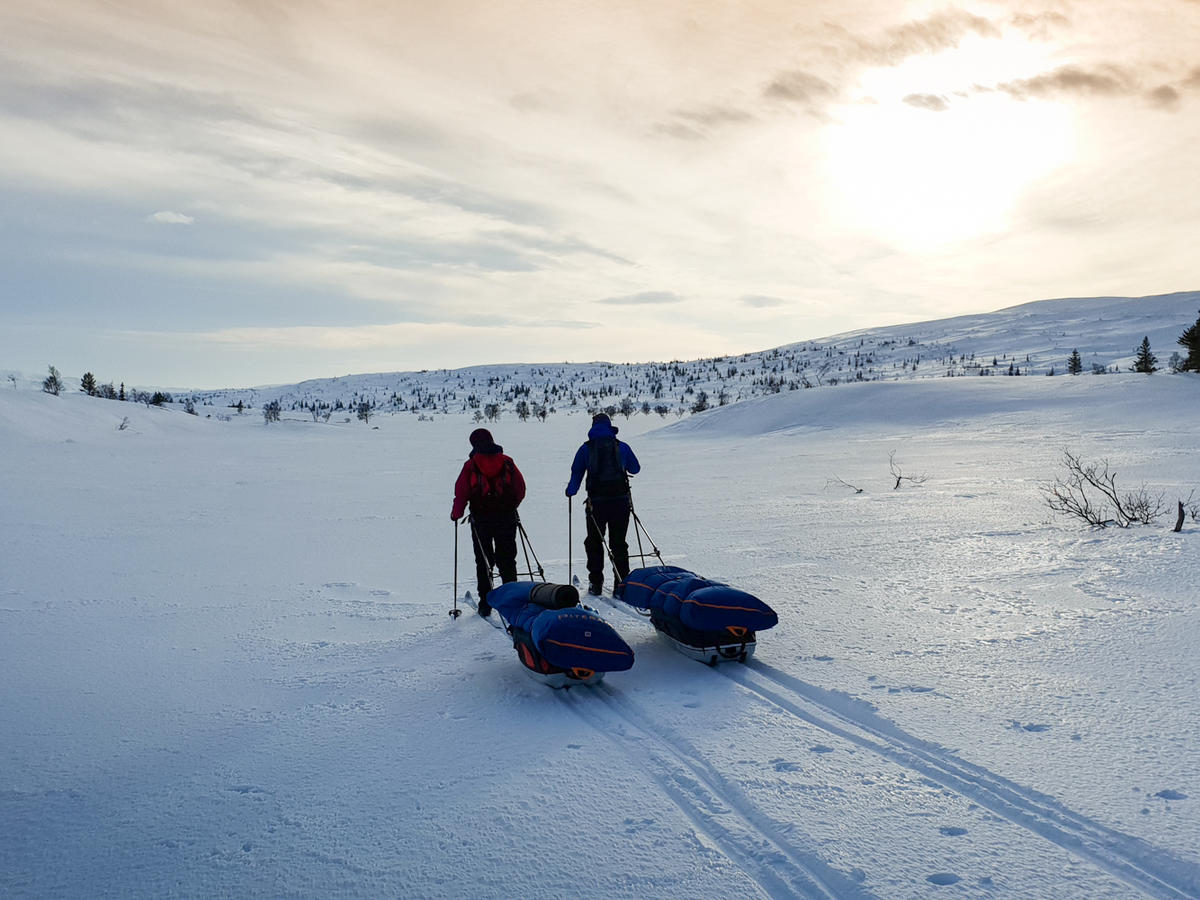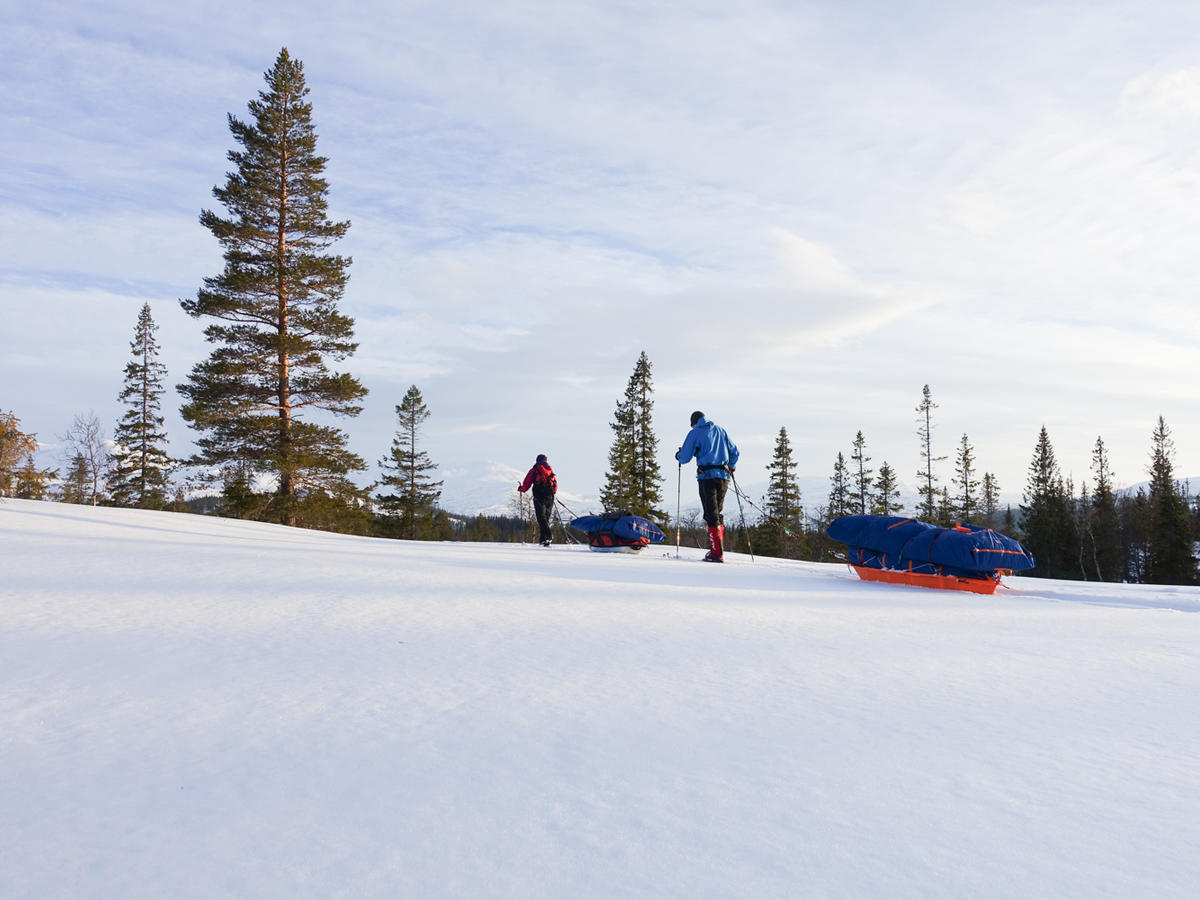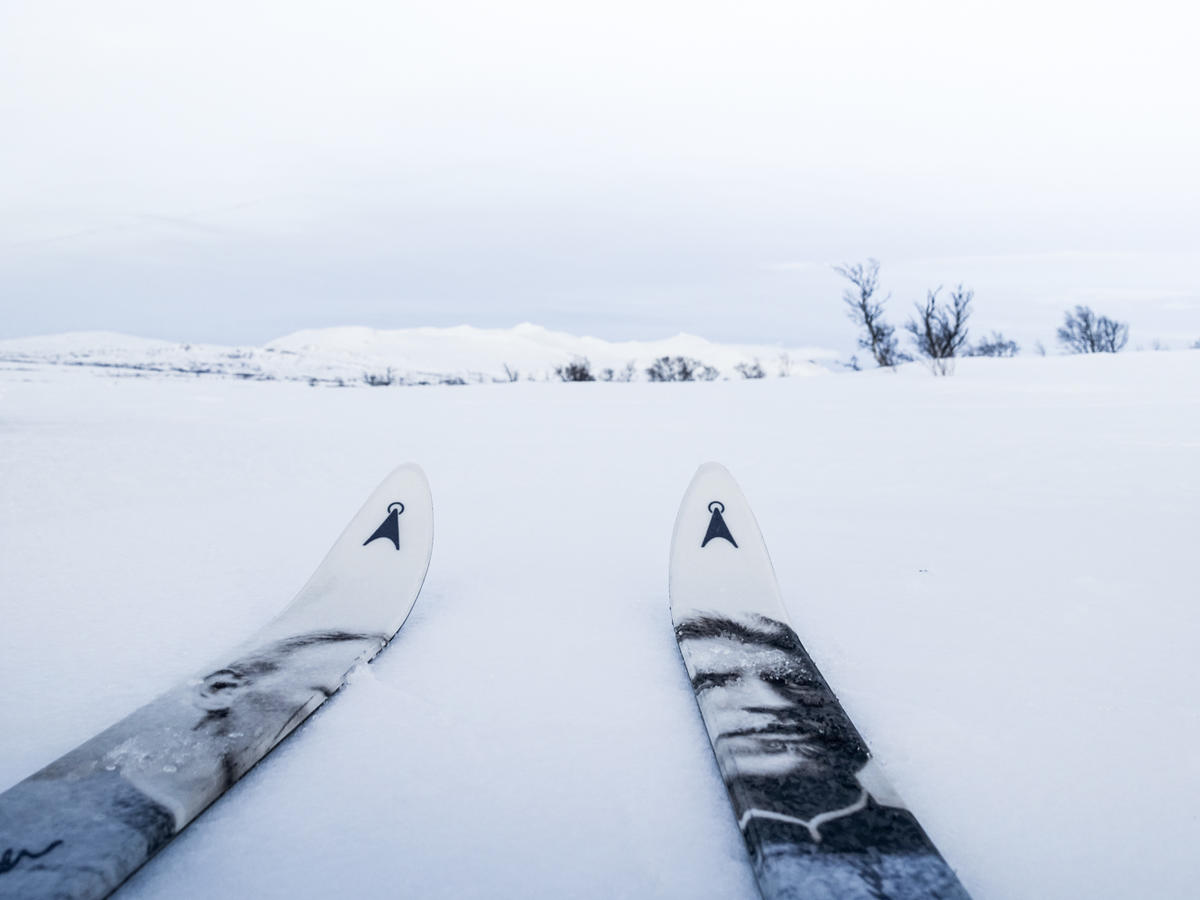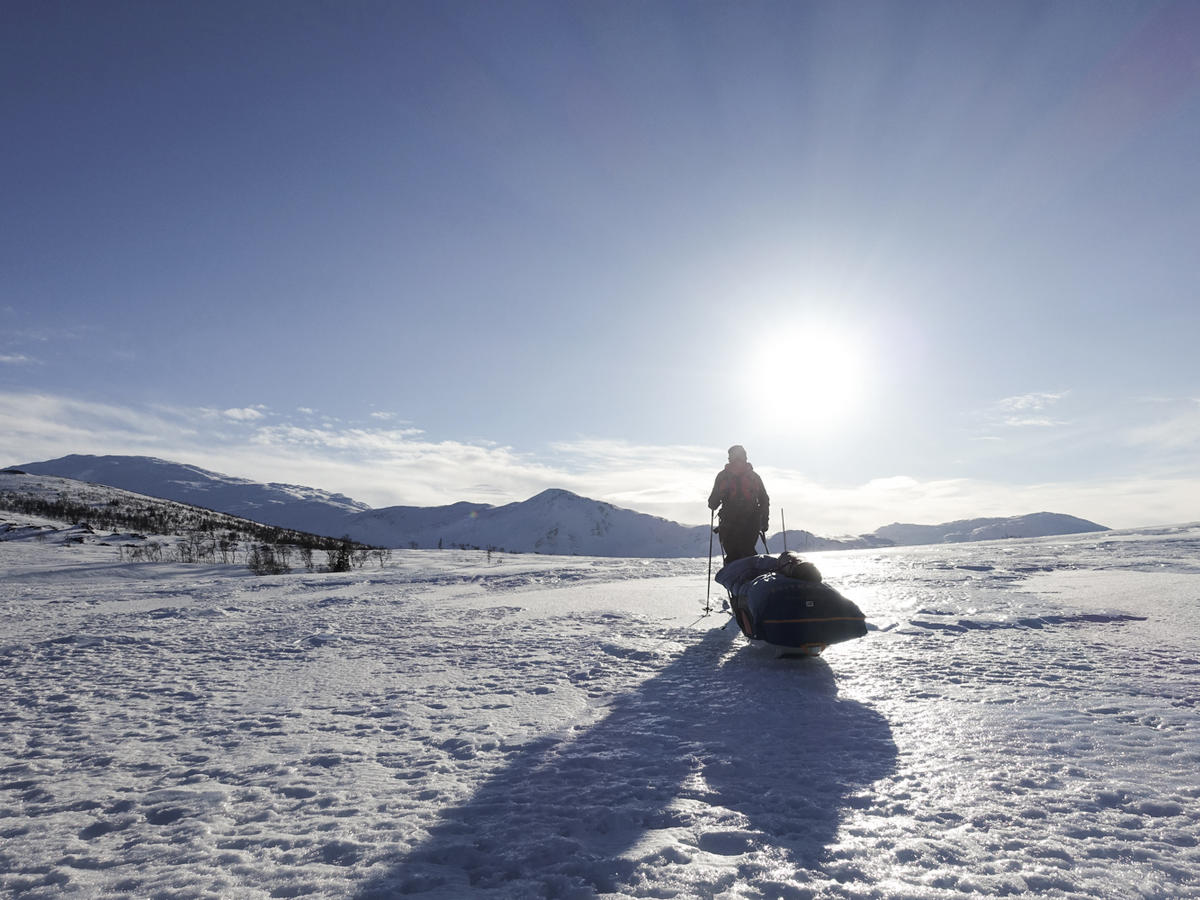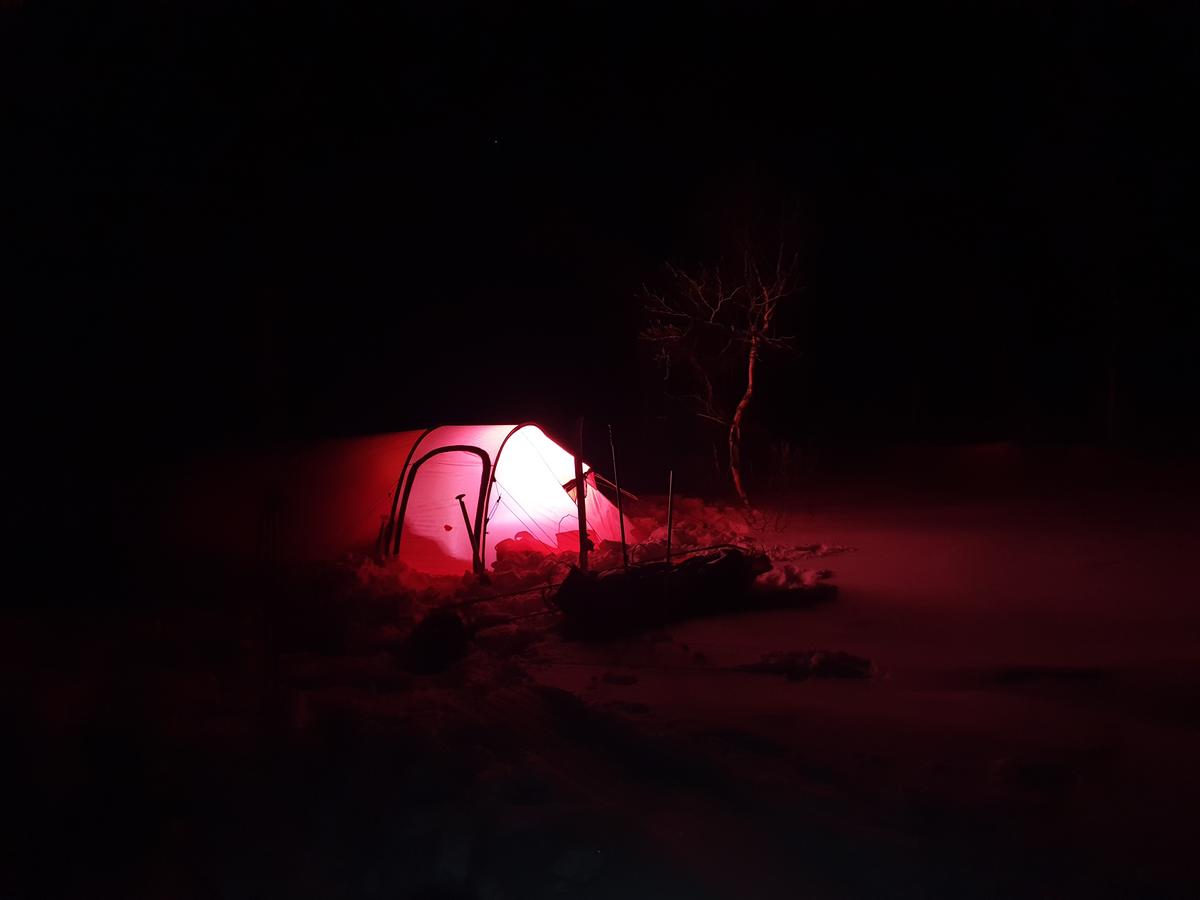Who would have thought that such beautiful nature experiences and a sense of wilderness are so close to one of Norway's largest cities! Read about our research trip across Norway.
Heading towards Trøndelag
It’s Friday morning, and we are packing a rather small SUV with skis, sleds, large winter sleeping bags, food, and all the other equipment three people need for a week’s winter adventure. Tetris skills are definitely required to fit everything in, but in the end, all three of us manage to sit relatively comfortably and safely, with minimal risk of flying objects. The trip is from Oslo to Trondheim - our plan was to travel all the way to the starting point of the journey and start skiing a little before setting up camp. However, the weather forecast predicts rain.
The past few days have involved heated debates within the group about whether we should head to Finnmarksvidda, where everyone has been before, and take a new route there, because the weather forecast in Finnmark looked at least a little better. Alternatively, we could stick to the plan and go to Trøndelag to cross Norway, which we’ve been dreaming of for a while... despite the rain. Two members of the group also work for Norrøna Adventure - one in the office and one as a guide - so we see great value in undertaking this journey, as we intend to feature it in Norrøna´s program. We believe this is an incredible trip that offers some of the best nature Norway has to offer, while also providing good logistics and cabins along the way where we can seek shelter if needed.
At this point, the weather forecast suggests we may indeed be seeking refuge.
A little luxury
So, here we are sitting in the car as it’s pouring rain. The thought of starting the trip today and getting all the gear soaked before a week-long expedition isn’t exactly appealing. So, like many other Norrøna expeditions, this one begins with a touch of luxury and good food. We book a hotel room in Trondheim, dine at a restaurant, and then head to the cinema to watch the film about Roald Amundsen - a perfect energy boost for the trip!
The next morning starts with a fantastic hotel breakfast before we finally hit the road to the start of the adventure. We’ve been carefully checking the weather forecast over the past few days because we’re still undecided on the route and whether to start in the east or west. The most common route is to begin at the Swedish border and make our way to the sea in Stjørdal, as the wind is usually most favorable there. This time, however, it seems better to go from west to east, so we drive to Selbuskogen Ski Resort.
Here, we park the car, which we plan to leave for the week. It turns out the parking fees are pretty steep, so we won’t mention exactly how much we ended up paying, but it’s definitely not recommended to park here for long periods. Fortunately, the rain has stopped, and the sun is starting to peek out. We pack our sledges, have a quick lunch, and finally, we’re on our way - Sweden, here we come!
Finally, we have our skis on
Our plan is to stay in a tent for the whole trip, but the route passes by cabins with suitable day stops along the way. Since a lot of weather has been predicted and we don’t have mobile coverage for most of the route, we decide to camp near the cabins instead. Today’s stage goes from Selbuskogen Ski Resort to Kvitfjellhytta. Much of the stage follows groomed tracks, so we meet many locals out on a Saturday ride.
We start in full expedition clothing, but as we head uphill with a relatively heavy sled in tow, in zero degrees and sunshine, we quickly shed layer after layer. Eventually, we get higher into the mountain terrain, and the tracks turn into some windswept scooter trails. At dusk, we arrive at Kvitfjellhytta. We check out all the cabins along the trip since we are also doing this as a research trip. Inside, we find two girls on a weekend getaway. We say hello, look around, then head out some distance from the cabin to set up our tent.
The next day, we wake up in the tent, and our tent routines aren't quite in place yet, so we don’t leave until around 09:30. Today’s stage also follows some beaten-up scooter tracks and regular ski tracks. As we approach Prestøyhytta, both tracks end, and no people are in sight. This is where the adventure really begins. We camp behind a nice "gapahuk", a simple shelter that we can use for cooking dinner, put on our skis, and walk a few hundred meters up the mountainside to check out Prestøyhytta. It’s an incredibly charming cabin that comes highly recommended. We meet a lovely lady who has taken a few extra days off after the weekend to enjoy a trip in the area. She will be the last person we see for a few days.
The next day is spent in beautiful, untouched nature with no markings. We get to test our map and compass skills and arrive safely in the stunning terrain around Schulzhytta.
Caught in bad weather at Ramsjøhytta
The next day, we’re heading up a high mountain, but first, there’s a stream valley to ford. We manage to have lunch in the sun before a storm rolls in. The wind picks up as we approach Ramskardet, the most exposed point on the trip, but luckily, it’s not too bad - yet. We meet a friendly guy in the wind who’s working to set up stakes in one of the most wind-exposed areas to guide people on their route. We cross Ramsjøen and head toward Ramsjøhytta, where we find a nice spot for our tents about 500 meters from the cabin. With the weather expected to turn harsh tonight, we build a solid wind wall. The terrain is a bit rough, and the tent is set up on a slight slope, so we make the wind wall even higher than usual. When we finally get in the tent, dinner tastes exceptionally good.
Every evening, we spend hours boiling water. It takes quite a while since one of the two stoves we brought with us has decided to malfunction and refuses to work. We cook 3 liters per person each night. Between boiling water, we eat dinner, enjoy some snacks and chocolate, and play dice games. Planning for the next day is also part of the routine. Tonight, the wind is really strong, and we’re thankful for every extra centimeter we added to the wind wall. As we prepare for the last trip out of the tent for the evening, we discover that the outer tent is covered in a complete snowpack. All our gear is buried in snow. We have to grab the shovels and cover any tiny gaps. There's no way we’re going outside to pee, so we try building a latrine in the outer tent. Surprisingly, it works quite well, as long as you dig deep enough and can cover it with snow after.
The next morning, the wind is still blowing. We take our time packing up camp and head to Ramsjøhytta, where we have lunch indoors before moving on. Thankfully, the wind gradually dies down, and we enjoy the day in a rolling plain landscape and mountain birch forest. The terrain is relatively easy, but it snowed quite a bit last night, so the snow is heavier to walk through. Eventually, we reach Storerikvollen, where we set up camp some distance from the cabin and build a new protective wall. We have mobile coverage here and can check the weather forecast, which says the wind will pick up again during the night, so we don’t take any chances.
Towards the Swedish Border
Now we’re approaching the Swedish border, and today we’re treated to a stunning day with views of the Sylan massif. We caught a glimpse of it yesterday through the clouds, but today we get to see it in all its glory. All three of us agree it’s one of the most beautiful mountain areas we’ve seen, truly spectacular, and we’re already starting to plan future trips here. Along the way, we encounter a large herd of reindeer, and we spot animal tracks, including what we’re pretty sure are wolverine tracks.
Now we’re heading toward Nedalshytta, but first, we need to cross a mountain pass. We have another sunny day and are really enjoying the trip, but as we near the top of the pass, we have to snap our hoods back and put on our slalom goggles because the wind hits us full force. We ski down some hills toward Nedalshytta, and when we arrive, it’s raining quite a bit. We drop our sleds and start walking toward the Swedish border. The border is a few kilometers uphill from the cabin. We high-five each other when we cross to the other side, take some photos, and then head back down.
The rain has created a layer of ice on the snow, so the descent is demanding to say the least. We’re very glad we left the sleds behind. Once back down, we spend some time debating whether we should sleep in a tent or in the hut to celebrate. Some in the group prefer the luxury of a cabin, while others think the whole trip should be done in a tent. In the end, the warmth and comfort of a cabin are too tempting, so we dry our clothes and sleeping bags by the fire and enjoy the evening in the cabin alone.
The next morning a chatty and ski-loving Brit comes by and gives us tips on where we can go down to Vækterstua, where he had come from. We cross Lake Nesjøen, this is a regulated waterway with changing water levels, so we need to be very careful. After a windy crossing over the lake and a descent from the mountain, we ski down the slopes and eventually arrive at Væktarstua. Here, we enjoy a great dinner and a well-earned drink before a taxi picks us up and drives us back to our car.
Last stretch on foot
When we finally get to the car, it’s completely out of power. Surprise! The temperatures have been well below freezing, so we knew this could happen. Fortunately, a local hero comes to the rescue, helps us with the jump start, and we’re finally able to drive down to Stjørdal for a warm bed. It’s late, and the whole gang is exhausted, so the shower will have to wait until morning. After three long showers, a sumptuous breakfast, and buying new running shoes, we’re ready for the last part of the adventure. We pack light rucksacks, lace up our trainers, dip our toes in the sea, and then start walking back to Selbuskogen Ski Resort. Several hours and 20 km later, we arrive and get to share the ride back to Stjørdal with a very nice lady. Then it’s back home to Oslo. A fantastic trip with magnificent natural experiences is behind us, and for you, this unique adventure can begin by clicking HERE.
PS: This trip is the opposite of our "Crossing Norway" trip, as it’s usually windy from east to west here. The walk is beautiful in both directions, and the route can change depending on the conditions. In any case, we make arrangements so you can complete the entire stretch from the Swedish border to the sea in Stjørdal, or vice versa.
Kathrine, Marit and Elise
